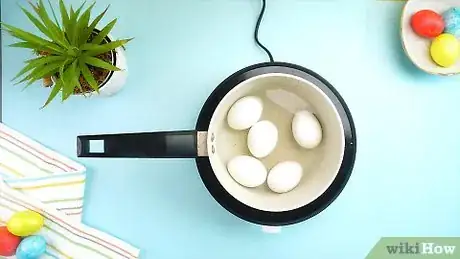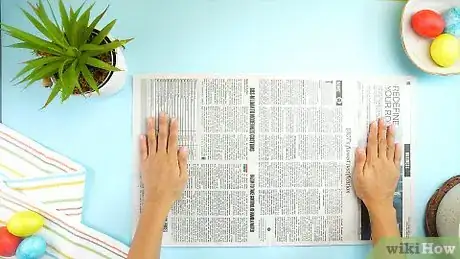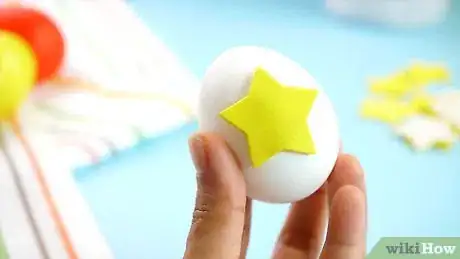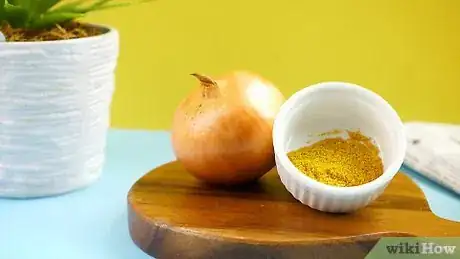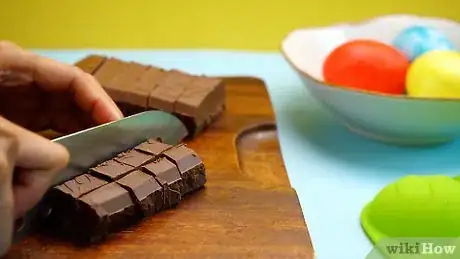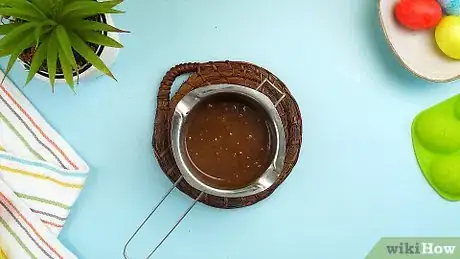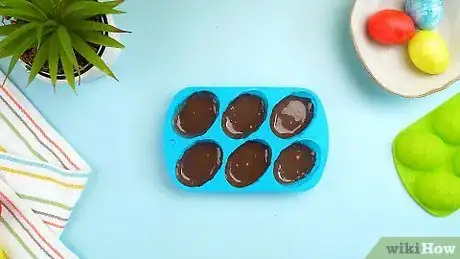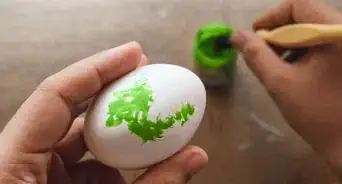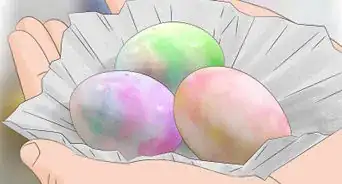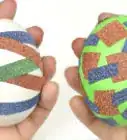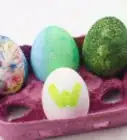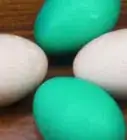This article was co-authored by wikiHow Staff. Our trained team of editors and researchers validate articles for accuracy and comprehensiveness. wikiHow's Content Management Team carefully monitors the work from our editorial staff to ensure that each article is backed by trusted research and meets our high quality standards.
There are 18 references cited in this article, which can be found at the bottom of the page.
The wikiHow Video Team also followed the article's instructions and verified that they work.
This article has been viewed 45,132 times.
Learn more...
Decorating Easter eggs is a great way to celebrate the holiday with family and friends of all ages. Dyeing is a traditional form of decorating, and you likely already have everything you need in your kitchen. Once you get basic dyeing down, you can take extra steps to add pizzazz to your finished product. You can also move away from dyeing and try your hand at molding chocolate Easter eggs. No matter how they turn out, you'll have delicious results!
Steps
Dyeing Easter Eggs
-
1Leave your eggs in boiled water for 10 minutes to make hard-boiled eggs. Place the eggs in a pot on the stove. Add enough water to cover them by 1 inch (2.5 cm), and then bring the water to a rolling boil over high heat. When it's boiling, cover the pot and take it off the heat. Set the pot aside for 10 minutes.[1]
- Once 10 minutes is up, put the eggs in an ice bath to cool.
-
2Cover your table or work surface with newspaper. Dye can easily stain surfaces so protect the area with a thick layer of newspaper. You can also use paper towels, an old towel you don't mind staining, or even a trash bag in a pinch.[2]Advertisement
-
3Add boiling water, vinegar, and food coloring to small bowls. Pour in 0.5 cups (120 mL) of boiling water, 0.5 teaspoons (2.5 mL) of white vinegar, and 10 drops of food coloring for each bowl. Stir to combine.[3]
- Make each bowl a different color. You can do the primary colors just by adding 10 drops of red to a bowl, 10 drops of blue to another, and so on. You can also mix colors to get different shades, such as 4 drops of green and 6 drops of blue for a blue-green or 5 drops of red and 5 drops of blue for a purple.
- If you want your colors to be more intense, add more drops of food coloring.
- Adding vinegar to the water helps make the dye brighter![4]
-
4Soak the eggs in the colors for 5 minutes or more. Use a spoon to dip the eggs into the dyed water. Let them soak for at least 5 minutes, turning them occasionally to make sure all sides get dyed. If you leave them in for longer, the colors will be darker.[5]
- You can also use tongs to hold the egg at an angle and only dye one side. Then, hold the other end in a different dye for a striped effect.
-
5Dry the eggs off on paper towels or in the carton. Lay the eggs on paper towels so they can dry completely. You can also set them back into the carton to dry off, particularly if you have a cardboard carton.[6]
- If you're planning on eating the eggs, don't leave them out of the refrigerator for more than 2 hours.[7]
Making Your Dyed Eggs More Interesting
-
1Make tie-dye eggs by adding a splash of oil to the dye water. Pour in a spoonful of olive oil or other cooking oil in one of the bowls of dye. Mix it around and then lower in an egg. Roll it around for a few minutes so it picks up color in some areas but not others. After a few minutes, pull it out and dry it off.[8]
- You can also create a similar effect with vinegar, shaving cream or whipped cream, and food coloring. Soak the boiled eggs in vinegar for 2 minutes and then dry them off. Spread out shaving cream or whipped topping in a baking dish and sprinkle food coloring on top, adding several colors. Swirl the colors around with a toothpick and then roll the eggs in the colors. Let them sit for 10 minutes before washing the mixture off.[9]
-
2Add stickers or letters before dyeing the eggs. Put shapes or letters on the eggs in fun designs. Dip the eggs like you normally would. Peel them off when you're done dyeing and the eggs are dry. You'll have fun designs in white left behind surrounded by the dye color![10]
-
3Draw on the eggs with a white crayon before dyeing them. Write fun sayings, draw shapes, or make zigzags all over the egg. You could also make polka dots! Once you're done, dye the eggs as you normally would, and the waxed area won't get dyed.[11]
- You can remove the wax if you want by holding the egg over a candle (not too close to the flame!) and then wiping the wax off.
-
4Wrap rubber bands around the eggs to make stripes. Use wide and small rubber bands. Wrap them in around the eggs so they cross over each other and are fairly tight. Dye the eggs as you normally would. Once they're dry, take the rubber bands off, and you'll have white stripes in the dye.[12]
-
5Make natural dyes from spices and plants. Create natural dyes by adding 4 cups (950 ml) of water and 2 tablespoons (30 mL) of vinegar to a pot. Then boil the mixture with spices or plants for 30 minutes to get your desired color.[13]
- For instance, use chopped beets for pink, chopped purple cabbage for blue, or yellow onion skins for orange. Add enough to fill the pot but still be submerged.
- Four yellow, pour in 3 spoonfuls of turmeric.
- When soaking the eggs in the dye, leave them for 30 minutes.
Molding Chocolate Eggs
-
1Prepare your molds for the chocolate by polishing and oiling them. Rub the inside the molds with a bit of paper towel to get out any debris and smooth them out. Put a little flavorless kitchen oil on another small piece of paper towel. Smooth the oil lightly into the molds.[14]
- The oil will help the chocolate pop out.
-
2Chop your chocolate into fine pieces. If you're using a chocolate bar, use a knife to cut it up into small pieces. Smaller pieces will melt more readily. You can also use small chocolate chips if you'd like.[15]
-
3Heat the chocolate over a double boiler. Place the chocolate in a heat-safe bowl that will sit on top of a pot. Put water in the bottom of the pot and set it on the stove with the bowl of chocolate on top. Bring the water to a simmer, stirring the chocolate on top to help it melt.[16]
- If you have a candy thermometer, heat the chocolate to 110 °F (43 °C).
- You can also melt your chocolate by placing it in the microwave at 50% power for 15-30 seconds at a time, stirring well each time you heat it. Continue doing this until it's completely melted.
-
4Let the chocolate cool once it's completely melted. Remove the bowl from the pot using kitchen gloves. Put it aside to cool. Don't let it cool all the way. It should be about body temperature when it's done.[17]
- If you have a thermometer, check for the chocolate to reach 95 °F (35 °C).
-
5Add a large spoonful of chocolate to each half mold and swirl to coat. Move the mold around so that the chocolate coats the inside of the mold. If you need to, use a pastry brush to completely coat it.[18]
- Pour any extra chocolate back into the bowl.
-
6
-
7Clean the edge of the mold with a flat edge. Run a ruler or a table knife around the edge of the mold to make a smooth edge. This process will help the 2 halves of the egg fit together in a moment.[21]
-
8Add more layers in the same way before chilling for an hour. Pour in the chocolate and swirl it around. Let it cool and then clean the edge of the egg. Keep going for 2-3 layers so you have a nice, solid layer of chocolate in the egg.[22]
- Put them in the refrigerator to set for 1 hour.
-
9Unmold the eggs and stick the 2 sides together using heat. Gently unmold the eggs so you don't break them. Put a baking sheet in the oven for a few minutes to heat up and then take it out once it's warm. Lay the eggs edge-side down on the pan for just a moment. Once you see they're melted a bit, pull the halves up and press them together to form the egg.[23]
- Work quickly as your body heat can melt the chocolate.
- For extra fun, add surprises in the eggs like truffles or small candies.
Community Q&A
-
QuestionHow do I make an Easter bonnet?
 Community AnswerThere are many ways to make an Easter bonnet. You can glue flowers or bows onto a hat you already own, or you could make your own hat. Try doing an internet search of some styles you like and try to recreate them.
Community AnswerThere are many ways to make an Easter bonnet. You can glue flowers or bows onto a hat you already own, or you could make your own hat. Try doing an internet search of some styles you like and try to recreate them. -
QuestionCan I decorate the egg without boiling it?
 SugavageCommunity AnswerYou can, but the egg won't stay fresh outside of the fridge for long. Also, the dye will wash off if you boil the egg after coloring it.
SugavageCommunity AnswerYou can, but the egg won't stay fresh outside of the fridge for long. Also, the dye will wash off if you boil the egg after coloring it.
Things You'll Need
Dyeing Easter Eggs
- Eggs
- Pot
- Paper towels
- Newspaper
- Heatproof small bowls or jars
- Vinegar
- Food coloring
- Spoons
- Tongs, optional
Making Your Dyed Eggs More Interesting
- Oil, optional
- Whipped topping, optional
- Shaving cream, optional
- Food coloring, optional
- Stickers, optional
- Toothpick, optional
- White crayon, optional
- Rubber bands, optional
Molding Chocolate Eggs
- Egg-shaped molds
- Paper towels
- Oil
- Chocolate
- Knife
- Baking pan
- Double boiler
References
- ↑ https://www.foodnetwork.com/recipes/food-network-kitchen/deviled-eggs-recipe-1973562
- ↑ https://www.realsimple.com/holidays-entertaining/holidays/more-holidays/dye-easter-eggs
- ↑ https://www.geniuskitchen.com/recipe/easter-eggs-egg-dye-160383
- ↑ http://www.education.com/science-fair/article/coloring-colorfastness-art-dyeing/
- ↑ https://www.realsimple.com/holidays-entertaining/holidays/more-holidays/dye-easter-eggs
- ↑ https://www.realsimple.com/holidays-entertaining/holidays/more-holidays/dye-easter-eggs
- ↑ https://www.geniuskitchen.com/recipe/easter-eggs-egg-dye-160383
- ↑ https://www.geniuskitchen.com/recipe/easter-eggs-egg-dye-160383
- ↑ https://www.delish.com/holiday-recipes/easter/g2327/make-marbled-easter-eggs/
- ↑ https://www.geniuskitchen.com/recipe/easter-eggs-egg-dye-160383
- ↑ https://www.epicurious.com/recipes/food/views/to-dye-easter-eggs-241824
- ↑ https://www.epicurious.com/recipes/food/views/to-dye-easter-eggs-241824
- ↑ https://www.goodhousekeeping.com/holidays/easter-ideas/how-to/a31737/natural-easter-egg-dyes/
- ↑ https://www.bbc.com/food/recipes/homemadechocolateeas_4891
- ↑ https://www.jamieoliver.com/features/how-to-make-a-chocolate-egg/
- ↑ https://www.bbc.com/food/recipes/homemadechocolateeas_4891
- ↑ https://www.bbc.com/food/recipes/homemadechocolateeas_4891
- ↑ https://www.greatbritishchefs.com/how-to-cook/how-to-make-an-easter-egg
- ↑ https://www.bbc.com/food/recipes/homemadechocolateeas_4891
- ↑ https://www.greatbritishchefs.com/how-to-cook/how-to-make-an-easter-egg
- ↑ https://www.bbc.com/food/recipes/homemadechocolateeas_4891
- ↑ https://www.greatbritishchefs.com/how-to-cook/how-to-make-an-easter-egg
- ↑ https://www.bbc.com/food/recipes/homemadechocolateeas_4891
About This Article
To make Easter eggs, start by boiling some eggs for 10 minutes and then dunking them in an ice bath to cool them off. While those are cooling off, fill several bowls with boiling water, a splash of white vinegar, and food coloring. Make each bowl a different color so you have lots of options to decorate your eggs with. You can even add a splash of cooking oil to the water to make your eggs tie-dye. If you want your eggs to have designs on them, draw on them using a white crayon before you dye them. The spots that you draw on won't get dyed, so you'll end up with a design at the end! To dye the eggs, soak them in the bowls for at least 5 minutes. When you're satisfied with the colors, set them on a paper towel or egg carton to dry. To learn how to make your own chocolate Easter eggs, scroll down!
